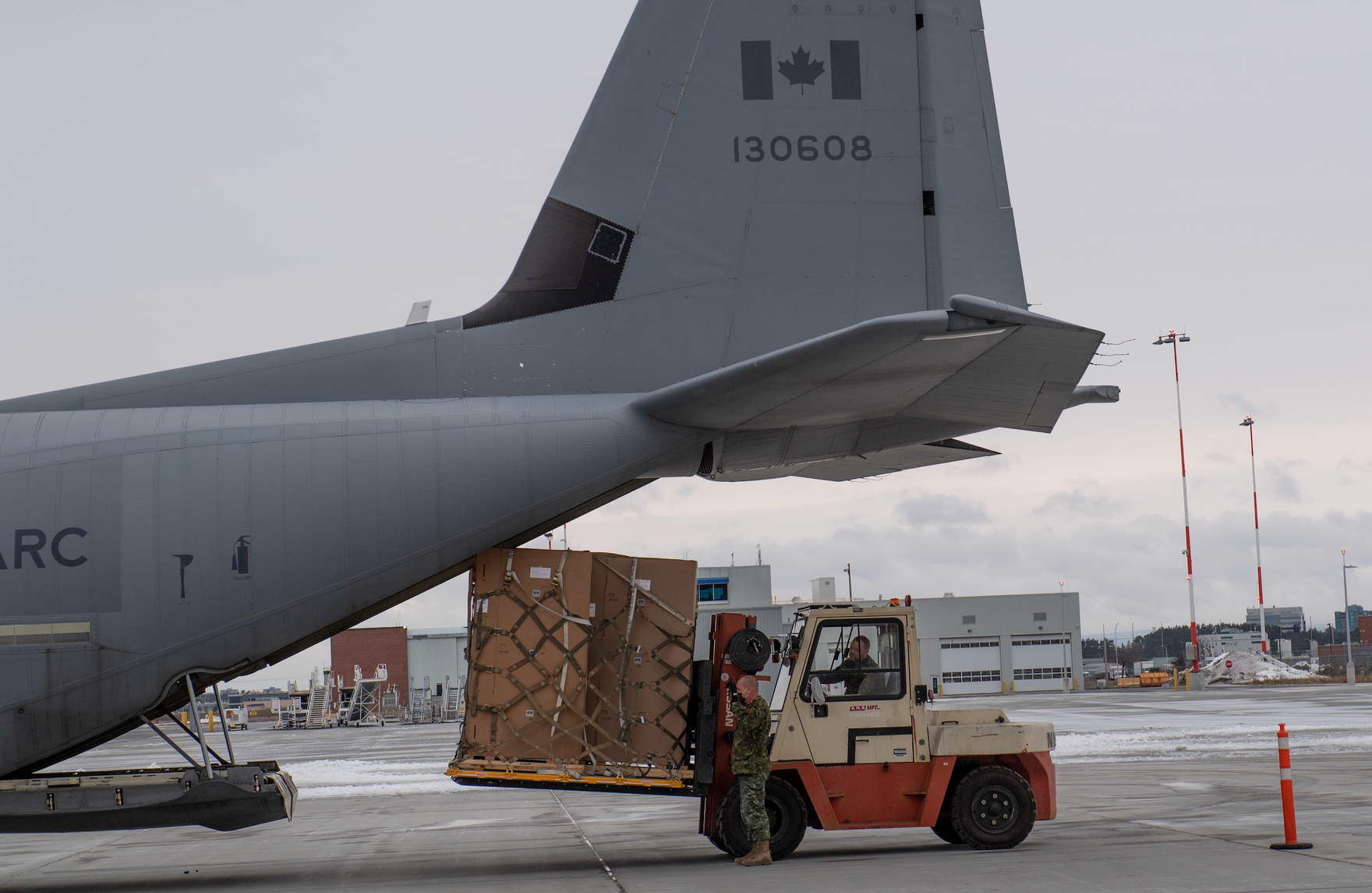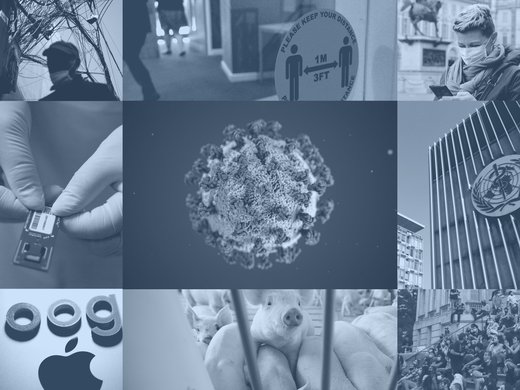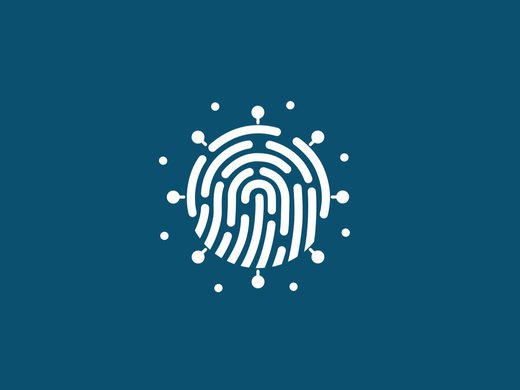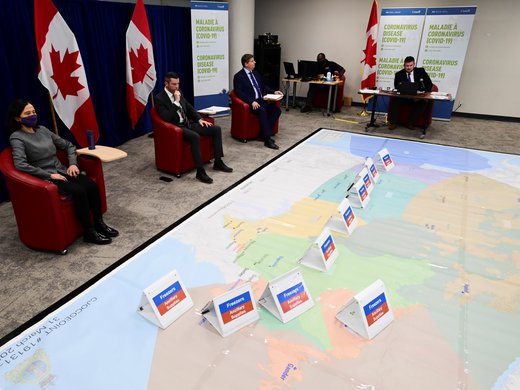Since the onset of the COVID-19 pandemic, questions have persisted about what role the Department of National Defence (DND) may have played in the government’s understanding of the dangers posed by SARS-CoV-2, the new coronavirus. The first months of the pandemic’s emergence and spread, from January to March 2020, were the critical period for early warning and response. We know that the Public Health Agency of Canada (PHAC), as the lead federal agency, failed to adequately assess the threat of COVID-19, and that the Canadian government’s understanding of the looming danger was painfully slow in taking shape. After the first notifications of an outbreak in Wuhan, China, fully two and a half months passed before the government began to take action to close the country’s borders and prepare for a national emergency.
The defence department and the Canadian Armed Forces (CAF) possess unique capabilities with regard to pandemic intelligence. The DND operates the largest intelligence organization in the federal government, headed by CFINTCOM (Canadian Forces Intelligence Command), a combined military-civilian agency dedicated to assessing threats to the Canadian military and the country’s security. The CAF also houses a Health Services Group, the responsibilities of which include monitoring health threats to the Canadian military and its operations.
The military had a pandemic response plan, or contingency plan, CONPLAN LASER, in place prior to the COVID-19 outbreak. The first phase of that plan was meant to be permanently activated; it called for mitigation planning and monitoring of worldwide pandemic threats. Thanks to Canada’s membership in the Five Eyes intelligence network, the intelligence-sharing relationship that links Canada to the United States, the United Kingdom, Australia and New Zealand, Canada was a member of a standing five-nation medical intelligence committee, the history of which stretches back to World War II.
But a picture has now begun to emerge, thanks to documents recently released under the Access to Information Act, that suggests the Canadian military was unable to put these considerable military intelligence capabilities to effective use in the early stages of the pandemic to answer a critical question: would the COVID-19 virus threaten Canadians?
The document record contradicts assurances provided last year to Canadians by the minister of national defence, Harjit Sajjan. On July 22, 2020, in response to an order paper question in the House of Commons and under questioning by the Conservatives, the Minister repeatedly said that the government had made its decisions “based on sound intelligence…to make sure Canadians are safe.” At the same time, he declined to divulge details of these intelligence reports.
It is now clear that the DND was first alerted to news of an unusual pneumonia-like outbreak in China on December 31, 2019. The source was ProMed, a US-based service that promulgated media reports on health threats globally. Regular DND reporting on COVID-19 began as early as January 7, 2020. The first in a series of “Defence Intelligence Daily” briefs covering the outbreak was issued on January 9. The first weekly intelligence briefing for the minister of national defence that discussed the disease was delivered January 17, 2020.
To its credit, the DND paid close early attention to news of the COVID-19 outbreak. But did it possess “sound intelligence,” as the minister claimed in Parliament? The evidence to provide an answer is now available.
Defence intelligence reporting began on an appropriately cautious note. The first report in the “Defence Intelligence Daily” for January 9, based on open sources, noted that Chinese health authorities had identified 59 patients who were suffering from an unknown type of pneumonia, with seven critically ill. It cited the Wuhan Municipal Health Committee as stating that there was no clear evidence of human-to-human transmission and that most of the patients had been connected to a local wild-animal and seafood market that had since been disinfected.
The report included a picture from a Chinese media source of the market undergoing disinfection. The report noted that there was insufficient information to permit a “full assessment” of the health risks of the disease, but also indicated that China’s surveillance and reporting of infectious disease outbreaks had improved since the SARS (severe acute respiratory syndrome) outbreak in 2003. It speculated that “other countries, including Canada, could see imported cases from China,” with Hong Kong likely to be the first area to provide clues to the disease’s spread.
Caution Superseded by Optimism
This early caution was soon superseded by a greater optimism that the virus posed little threat. In a report one week later, on January 16, the “Defence Intelligence Daily” commented that “the outbreak appears to be contained” and that “significant disease spread outside of China is unlikely.” Chinese health authorities were commended for their quick reporting and effective response “while communicating pertinent information to international health authorities.”
This defence intelligence report would have formed the basis for Minister Sajjan’s first weekly intelligence briefing to mention the emergent disease the following day. Optimism was the reigning view.
As the severity of the COVID-19 crisis in China mounted, defence intelligence reporting persisted in believing that the Chinese authorities had the situation under control and were being “open and transparent.” An intelligence report for January 23, 2020, suggested that COVID-19 caused less severe illness than SARS and cited misleading statistics regarding low mortality rates in older populations (ages 75 and up). It concluded that “significant transmission of the disease outside of China is unlikely.”
This assessment under-reported existing confirmed cases outside of China and did not align with PHAC’s daily situation report from January 23, which noted that “further identification of [COVID-19] cases within China and in other countries is expected.” According to defence intelligence, the COVID-19 risk to CAF/DND personnel was considered “negligible.” Whether the DND’s assessment of “negligible” risk comported with PHAC’s assessment of “low” risk was left unclear. Either way, the assessment was to prove drastically off the mark.
Despite the declaration by the World Health Organization (WHO) of a “Public Health Emergency of International Concern” on January 30, and rising case count numbers in and beyond the borders of the People’s Republic of China, defence intelligence reporting remained unchanged in early February 2020, one month after original news of the disease outbreak.
Following an apparent gap of three weeks from the initial defence intelligence briefing on COVID-19 on January 17, Minister Sajjan received an update on February 5. The briefing noted a “recent significant increase” in reported COVID-19 cases globally but continued to assess that the general risk to CAF/DND personnel was “negligible.” This assessment needs to be placed alongside the data contained in that day’s PHAC daily situation report, which drew its figures from the WHO and other authoritative national centre reporting. According to PHAC, there were 24,324 cases across China with 490 deaths; 217 cases had been reported outside China in 27 countries. By this stage, COVID-19 had made landfall in Canada, with five reported cases.
In discussing developments in China, Sajjan’s intelligence briefing on February 5 suggested that while the death rate in that country would increase, it would not be due to the virulence of the disease but rather to lack of medical care, overstressed medical infrastructure and decisions to close public transit. It is not a stretch to suggest that at this stage DND intelligence simply did not understand developments in China and remained blind to COVID-19’s global spread. The implication that China could control the outbreak was at odds with criticisms of its lockdown approach, which was seen as authoritarian, unprecedented and unwise rather than as an all-out emergency response to a calamitous health situation. The DND view was also contradicted by the fact of disease spread.
The next month, the DND intelligence outlook on COVID-19 became unsettled. A Chief of the Defence Staff (CDS) briefing on February 18 maintained that “we have seen no evidence to suggest the virus has changed in infectivity or transmissibility and we assess the pandemic potential remains low.” A week later, the “Defence Intelligence Daily” report had a different assessment, that COVID-19 is “very likely to become a pandemic, meaning worldwide spread of the disease will occur despite containment.” The “Defence Intelligence Daily” simply noted, without comment, that the PHAC risk assessment of the threat from COVID-19 to Canada and Canadians remained “low.”
The minister was briefed by defence intelligence on COVID-19 developments on February 21, February 28, March 6 and March 13. The latter three briefing documents have not been released under the Access to Information Act. The one released for February 21 is too heavily redacted to derive any sense from it. It is unlikely that the minister was told anything that diverged from other forms of defence intelligence reporting. Throughout this period, a “low” risk rating for impacts of COVID-19 on CAF operations outside Canada was generally maintained, with some risks raised to “medium” for operations in a few selected countries. In February? Defence intelligence continued to note and defer to PHAC threat assessments of a “low” risk to Canada and Canadians. Inexplicably, the minister’s weekly defence intelligence brief was ended as a series on March 13 and stood down for two months until May 15.
An important stream of DND medical intelligence reporting on COVID-19, separate from the defence intelligence products, had begun on January 21. From that date forward the CAF Health Services Group, operating under the umbrella of CFINTCOM, began producing a weekly “SITREP” (situation report) on the virus’s status. This was the most detailed reporting available in the DND medical intelligence portfolio and it was shared with the Privy Council Office and Global Affairs Canada. There is no evidence it was shared with PHAC, an indication of the failure of any more integrated thinking about COVID-19 risks across government.
It is unlikely these lengthier SITREP products landed on the defence minister’s desk. Their intended audience was CAF operational and planning staff, health services and intelligence personnel. While they offered a greater degree of nuance in their observations and a greater patina of health evidence related to the disease outbreak, the baseline assessments of the threat from COVID-19 did not diverge from those of the other defence intelligence reports circulated within the DND.
The CAF Health Services Group was principally mandated to provide threat assessments on the impact of disease outbreaks on CAF operations, and so geared their assessments to potential impacts on operational deployments and force readiness rather than to individual health risks to personnel. Even so, their force readiness assessments tempted confusion through statements such as this: “The general risk to CAF/DND personnel continues to be NEGLIGIBLE, due to no reduction in mission capability” (SITREP for January 31, 2020).
On the potential impacts of COVID-19 to CAF operations at home and abroad, the health services group judged these to be “negligible” from its first SITREP issued on January 21, 2020, through to early February 2020. This was a curious ranking in the context of the group’s own taxonomy, which rated risks to operational readiness at three defined levels — low, medium and high. “Negligible risk” was presumably something slighter than low risk, but it was never defined.
The CAF Health Services Group may have recognized this anomaly, when it raised its general risk assessment for the CAF to “low” on February 11, 2020. A “low” risk was characterized as one where “a health hazard exists but little or no impact to unit readiness/mission capability is expected.”
As of March 16, 2020, the CAF Health Services Group’s assessment of low risk to CAF operations in general was abandoned and replaced by more specific risk ratings for selected overseas deployments. None, other than a non-existent deployment to China, was rated as high risk.
The Precautionary Principle
That “low risk” COVID-19 rating for general CAF operations was maintained until March 16, 2020, the date when the true threat posed by COVID-19 was finally dawning on Canadian authorities. The low-risk judgment was not affected by elevated WHO risk ratings, by the WHO declaration of a “Public Health Emergency of International Concern” on January 30, by the UK declaration of a public health emergency on February 10, by outbreaks in Iran in February, or by the serious situation that developed in Northern Italy in February, with attendant lockdowns and a health crisis of grave proportions that portended a spreading European danger. It was not even altered by statements in the SITREPS in early March that “an exponential increase in global cases has begun.”
As of March 16, 2020, the CAF Health Services Group’s assessment of low risk to CAF operations in general was abandoned and replaced by more specific risk ratings for selected overseas deployments. None, other than a non-existent deployment to China, was rated as high risk. As of March 16, the CAF Health Services Group’s SITREP shifted to a prediction of the duration of the pandemic — which they pegged at six months. This, of course, proved wrong. The group’s SITREPS for mid-March to late March failed to catch up with a rapidly changing PHAC risk assessment, because they had no access to PHAC risk assessments, only to the summaries presented in PHAC’s own “Daily Situation Reports.”
The CAF Health Services Group’s SITREP reporting took no notice of the relevance of the “precautionary principle” regarding estimating risk in the absence of full medical data. The importance of the precautionary principle had been emphasized in Justice Campbell’s Ontario judicial inquiry in the aftermath of the SARS outbreak of 2003, which killed 44 Canadians, with 438 probable and suspected cases. The COVID-19 death toll surpassed that of SARS on March 27, 2020.
In Justice Campbell’s final report, issued in 2006, he included this statement:
Perhaps the most important lesson of SARS is the importance of the precautionary principle. SARS demonstrated over and over the importance of the principle that we cannot wait for scientific certainty before we take reasonable steps to reduce risk. This principle should be adopted as a guiding principle throughout Ontario’s health, public health and worker safety systems.
If we do not learn this and other lessons of SARS, and if we do not make present governments fix the problems that remain, we will leave a bitter legacy for those who died, those who fell ill and those who suffered so much. And we will pay a terrible price in the face of future outbreaks of virulent disease, whether in the form of foreseen outbreaks like flu pandemics or unforeseen ones, as SARS was.
The precautionary principle was certainly not taken as a guideline within the DND. Instead, the medical intelligence experts wanted more clinical data and were unprepared to make predictions about the key issue of human-to-human transmission of the virus. The DND’s February 17 SITREP noted: “More clinical data from the COVID-19 cases in China is needed to accurately determine the probability of sustained transmission outside of China. The uncertainty of available data and intelligence gaps on countries reporting cases of COVID-19 make it very difficult to assess the impact to CAF operations with confidence.”
Exactly the same comment was repeated in the SITREP one week later, despite a note that the European Centre for Disease Prevention and Control (ECDC) had found that “the transmissibility of this virus is sufficient for sustained community transmission.” If medical intelligence experts lacked confidence in their threat assessments, this did not translate into an unwillingness to continue to assert a low risk rating for COVID-19. Nor were any caveats on confidence levels applied to the risk judgments. In both aspects, the CAF Health Services Group’s risk assessments were clearly inadequate.
One notable feature of the CAF group’s SITREP products was a constant refrain that characterized media reporting as inexpert, obsessed with reporting quickly rather than accurately, and prone to alarmism, particularly in the context of making false comparisons between COVID-19 and SARS. A SITREP comment in the January 21, 2020, report noted, “Fear and misinformation, fueled by inaccurate media reporting and comparison of this virus to SARS will lead to more unfounded reports.” Similar statements were included in the SITREPS for January 22, January 27, January 28, January 31, February 3 and February 17.
The analysts in the CAF Health Services Group, by contrast, clearly wished to place themselves on a professional pedestal above media reporting, even though they also clearly relied heavily on open-source intelligence, including from media.
Alarmism was to be avoided at all costs. This outlook permeated DND intelligence reporting through the first three months of the global COVID-19 crisis and deprived its products of an effective early-warning capacity. It wasn’t until March 30, 2020, that the phrase “worst case” was used for the first time, in association with a prediction that if the impacts of COVID-19, now recognized as a pandemic with exponential spread, were not mitigated in Canada, it could lead to a quarter of a million deaths in the country.
A Multi-Agency Fusion Centre
Based on the available medical intelligence reporting for the first three months of the COVID-19 outbreak, there is clear evidence of assessment failure rooted in faulty assumptions that were allowed to persist past the point where evidence supported them: assumptions about the uniqueness of the disease threat to China and, in particular, to the dense urban environment of Wuhan, a city of 11 million; about the ability of China to contain the disease; about the disease’s mild severity; and about “limited” human-to-human transmission of the virus. They blunted any appreciation of the looming global threat posed by the COVID-19 virus.
Whatever Minister Sajjan may have believed about the intelligence briefings delivered to him, they were not based on “sound intelligence.”
The DND medical intelligence outlook was hardened early on in the crisis, on the basis of scant evidence, and subsequently operated in an echo chamber in which it found its own unchanging risk assessments supported by those presented by PHAC and by the US Centers for Disease Control and Prevention. Changes to the WHO’s risk assessment for COVID-19 in late January, which ranked the risk as very high in China and high at the regional and global levels, were noted but dismissed.
Global spread, especially as it impacted the developed health care systems of Europe in February 2020, was noted but ignored in terms of its implications for Canada and North America. A key principle of sound intelligence assessment — the need for contestation and challenge — was absent from the system. DND medical intelligence simply accepted the designated PHAC risk assessment levels, as coming from the “lead” federal agency. They had no direct access to the PHAC assessments themselves, which suffered from very serious methodological problems unknown to the DND. PHAC risk assessments offered no challenge to the similar views held by DND intelligence, and vice versa. This reality suggests a strong element of groupthink at work. There appeared to be no contrarians, no dissenting voices, no organized “Team B” alternative analysis anywhere on offer.
Sound intelligence is a necessary ingredient for sound decision making. If Canada’s response to future pandemic and other biosecurity threats is to be improved, an essential starting point will be in the quality and impact of threat assessments. We have known since the tabling of the Auditor General’s report Pandemic Preparedness, Surveillance and Border Control Measures on March 25, 2021, that PHAC risk assessments were fatally flawed. To that dismaying knowledge we must now add an understanding that the risk assessment system deployed by the DND — despite its potential capabilities in terms of access to intelligence, long experience with threat-assessment reporting, ready contingency planning and dedicated expertise — was equally flawed.
The report of the independent panel convened by the health minister to examine the workings of the PHAC Global Public Health Intelligence Network (GPHIN) came to an important finding that reached beyond the minister’s intended limited mandate for the panel’s work. Understanding that GPHIN information was of little use unless it was properly integrated in a risk assessment system, the panel argued that PHAC should create a dedicated Risk Assessment Office, with formal responsibility for its work charged to the chief public health officer of Canada.
Let us hope that PHAC will take this recommendation to heart and make it happen — although it is only a recommendation. But even this will not suffice. The circumstance in which a lead federal agency is deferred to in its judgment, without question, about global disease outbreak threats, as the DND record demonstrates occurred, cannot constitute a robust intelligence system.
What is required is a multi-agency fusion centre for biosecurity intelligence, early-warning and threat assessment. Canada’s allies are building such capacity. So must we. Such a fusion centre must create pathways to ensure its findings are challenged through simulations and exercises, outside expertise and regular public updates on biosecurity threats. It must embrace the precautionary principle, put scientific waiting for complete evidence aside, and develop a view of what constitutes a “reasonable worst case” as a baseline for response planning and mitigation measures, including an all-important public communications strategy.
It must be able to communicate its findings to key decision makers across government and to the prime minister and the Cabinet. To underestimate biosecurity threats, as occurred with COVID-19, is a recipe for future disaster.



